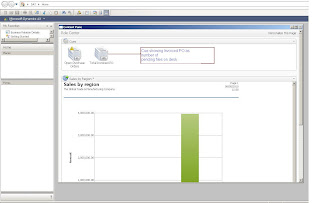RoleCente's main purpose is to show various data on homepage which user will get to see all at a glance . Cue is also one among them .
Basically Cues in DAX 2009 are used for visual representation of data . In Technical terms Output of Query is represented graphically.
How Cue Works
1. Open PurchTable form , click on advanced filter (Ctrl + F3)
2. Give any criteria ( status == Invoiced) and click on modify -->Save as Cue
3. Save the Cue by assigning Cue Id as "Total_POInvoiced" , Security profile(who all can use)
4. Created Cue can be viewed in Basic-->Setup->RoleCenter->Edit Cues.
5. In order to deploy , Edit Role center homepage
6. If you click on Cue "Total Invoiced PO " on Rolecenter you will be navigated to form which will show only invoiced purchase orders.
Technically :
When you create Cue , record gets created in CuesQuery Table with Formname , menuItemName and Query created from user criterias.
So when user click on Cue , It will take you to Form from where you created Cue by using the value from menuItemname.
Following X++ Job Creates Cue for customer form.
static void DEV_createCue(Args _args)
{
CuesQuery cuesQuery;
cuesQuery.clear();
Basically Cues in DAX 2009 are used for visual representation of data . In Technical terms Output of Query is represented graphically.
How Cue Works
1. Open PurchTable form , click on advanced filter (Ctrl + F3)
2. Give any criteria ( status == Invoiced) and click on modify -->Save as Cue
3. Save the Cue by assigning Cue Id as "Total_POInvoiced" , Security profile(who all can use)
4. Created Cue can be viewed in Basic-->Setup->RoleCenter->Edit Cues.
5. In order to deploy , Edit Role center homepage
a. Click on Add new webPart and select Cues Web Part.
b. Click on modify webpart and select above created Cue "Total_POInvoiced" in
property sheet .
c. Click on Apply and Ok .
d. When you exit edit mode , you will see total number of pending Invoices as image .
6. If you click on Cue "Total Invoiced PO " on Rolecenter you will be navigated to form which will show only invoiced purchase orders.
Technically :
When you create Cue , record gets created in CuesQuery Table with Formname , menuItemName and Query created from user criterias.
So when user click on Cue , It will take you to Form from where you created Cue by using the value from menuItemname.
Following X++ Job Creates Cue for customer form.
static void DEV_createCue(Args _args)
{
CuesQuery cuesQuery;
Query query = new Query(querystr(Cust));
;cuesQuery.clear();
cuesQuery.CueId = "TST_CustQuery2";
cuesQuery.Caption = "Cue test for CustTable";
cuesQuery.CueVersion = 1;
cuesQuery.CreatorUserId = curUserid();
cuesQuery.FormName = "CustTable";
cuesQuery.DataSourceName = "CustTable";
cuesQuery.Query = query.pack();
cuesQuery.ClientMenuItemName = "CustTable";
cuesQuery.CueMin = 1;
cuesQuery.CueMax = 10;
cuesQuery.Threshold = 0;
cuesQuery.ThresholdCriteria = CuesThresholdCriteria::None;
cuesQuery.SecurityAccessFlag = CuesSecurityFlag::SpecifiedProfiles;
cuesQuery.AdditionalValFunc = CuesAdditionalValFunc::None;
cuesQuery.AdditionalValField = " ";
cuesQuery.AdditionalValTable = " ";
if (cuesQuery.validateWrite())
{
cuesQuery.insert();
info(strfmt("Cue %1 Created with SecurityRights as %2",cuesQuery.CueId,cuesQuery.SecurityAccessFlag));
}
}





No comments:
Post a Comment